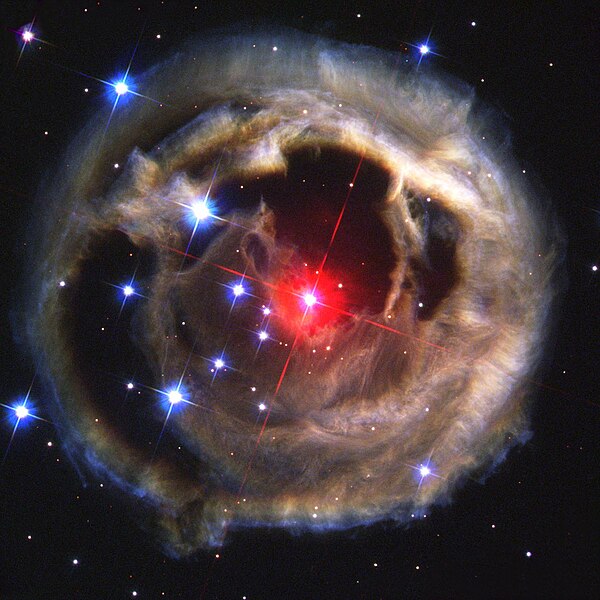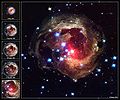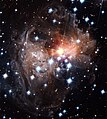文件:V838 Mon HST.jpg

Ê̤ṳ-lāng chék-cháung:600 × 600 chiông-só. Gì-tă hŭng-biêng-lŭk: 240 × 240 chiông-só | 480 × 480 chiông-só | 768 × 768 chiông-só | 1,024 × 1,024 chiông-só | 1,651 × 1,651 chiông-só.
Nguòng-dā̤ gì ùng-giông (1,651 × 1,651 chiông-só, ùng-giông duâi-nâung: 276 KB,MIME lôi-hìng: image/jpeg)
Ùng-giông lĭk-sṳ̄
Sōng-dĕk siŏh bĭk nĭk-gĭ/sì-găng lì káng hiā sèng-hâiu gì ùng-giông.
| Nĭk-gĭ/Sì-găng | Sáuk-liŏk-dù | Chióh-cháung | Ê̤ṳng-hô | Suók-mìng | |
|---|---|---|---|---|---|
| hiêng-káik-sì | 2004 nièng 12 nguŏk 21 hô̤ (B2) 06:18 |  | 1,651 × 1,651(276 KB) | Evil Monkey | In January 2002, a dull star in an obscure constellation suddenly became 600,000 times more luminous than our Sun, temporarily making it the brightest star in our Milky Way galaxy. The mysterious star, called V838 Monocerotis, has long since faded back to |
Lièng-giék
Mò̤ hiĕk-miêng lièng gáu ciā ùng-giông.
Cuòng-mĭk ùng-giông sāi-ê̤ṳng cìng-huóng
Â-dā̤ gì gì-tă wiki găk lā̤ sāi cī-bĭh ùng-giông:
- af.wikipedia.org gì sāi-ê̤ṳng cìng-huóng
- ang.wikipedia.org gì sāi-ê̤ṳng cìng-huóng
- an.wikipedia.org gì sāi-ê̤ṳng cìng-huóng
- ar.wikipedia.org gì sāi-ê̤ṳng cìng-huóng
- مجرة
- مقراب هابل الفضائي
- مستخدم:Roberto Mura
- V838 وحيد القرن
- ويكيبيديا:صور مختارة/الفضاء والكون/نظرة إلى الأعلى
- بوابة:علم الفلك/صورة مختارة
- تسمية النجوم المتغيرة
- مستعر أحمر ساطع
- ويكيبيديا:ترشيحات الصور المختارة/V838 وحيد القرن
- ويكيبيديا:صورة اليوم المختارة/سبتمبر 2019
- قالب:صورة اليوم المختارة/2019-09-29
- بوابة:علم الفلك/صورة مختارة/75
- ويكيبيديا:صورة اليوم المختارة/أغسطس 2022
- قالب:صورة اليوم المختارة/2022-08-13
- ast.wikipedia.org gì sāi-ê̤ṳng cìng-huóng
- az.wikipedia.org gì sāi-ê̤ṳng cìng-huóng
- be.wikipedia.org gì sāi-ê̤ṳng cìng-huóng
- bs.wikipedia.org gì sāi-ê̤ṳng cìng-huóng
- ca.wikipedia.org gì sāi-ê̤ṳng cìng-huóng
- cs.wikipedia.org gì sāi-ê̤ṳng cìng-huóng
- cy.wikipedia.org gì sāi-ê̤ṳng cìng-huóng
- da.wikipedia.org gì sāi-ê̤ṳng cìng-huóng
- de.wikipedia.org gì sāi-ê̤ṳng cìng-huóng
- de.wikibooks.org gì sāi-ê̤ṳng cìng-huóng
- el.wikipedia.org gì sāi-ê̤ṳng cìng-huóng
- en.wikipedia.org gì sāi-ê̤ṳng cìng-huóng
檢視此檔案的更多全域使用狀況。








